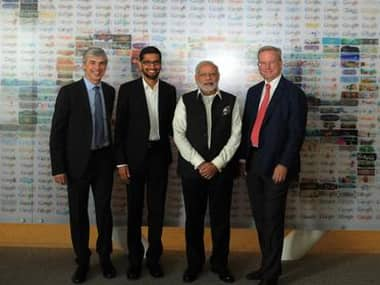As predicted, PM Narendra Modi’s second day stint at the Silicon Valley turned out to be bigger and fancier. With a town hall with Mark Zuckerberg, Google’s headquarter tour, India-US Startup Konnect, and speech at SAP Center, Modi made it clear that India is “indeed” dominating 21st century and is the next big frontier for US tech powerhouses. [caption id=“attachment_2447534” align=“alignleft” width=“380”]  Twitter[/caption] It was very clear from start that Modi’s Silicon Valley is not just about the PM pitching Digital India but also the tech giants wooing the head of the largest democracy at the same time for their technologies. As Firstpost mentioned earlier , the Indian PM is also going to experience some of the most cutting edge technologies emerging from Silicon Valley with huge potential to transform India.
At Google’s headquarters, Modi was taken around by Google CEO Sundar Pichai and shown demos of cutting-edge technologies the search engine giant is working on including, Project Iris, Street View and Google Earth. The Prime Minister also attended the Code for India event at the Google office.
[embed]https://twitter.com/narendramodi/status/648305723797929984[/embed]
Project Iris – Google’s smart contact lens that measure glucose levels . The lens is able to measure glucose levels in diabetics by analysing their tears and may be on the market before 2019 . India, which has the largest diabetes population in the world, could be the most relevant market for Google to launch its lenses if the cost factor remains viable for Indian wallets.Modi was also given a presentation of Google Earth. Pichai explained navigational, safety and other uses of Street View and Google Earth.
In addition, PM also encouraged Google employees to develop apps which could benefit the common man, and urged them to look for solutions to problems like poverty.
On the other hand, Pichai elaborated on the partnership for free Wi-fi at 500 Indian railway stations. He said that Google will provide high speed internet services at 100 railway stations in India initially, and then expand it by 400 more by next year. “The Wi-fi services will be provided to support ‘Digital India’ campaign,” he added.
Google said it will also launch an Android next month enabling users to type in 11 Indian languages.
At Facebook town hall meet, PM Modi’s 50-minutes long encounter with Mark Zuckerberg was nothing to do with technology showcase, but discussion on how communities can work together to address social and economic challenges. The discussion, however, had no mention of Facebook’s Internet.org project, which failed miserably in India. The questions were relatively safe and generic.
[embed]https://twitter.com/narendramodi/status/648307754067558400[/embed]
In another event, PM Modi chaired a roundtable meeting on renewable energy, with top energy CEOs and experts, in San Jose. Participants were of the view that states and cities in India should be allowed to take the lead in clean energy initiatives. A related thought was that the current grid is not designed for carrying the 175 GigaWatts (GW) of renewable energy that India is targeting, and therefore a complimentary effort is required on the grid side. Private investment was emphasized as vital for realizing the vision of 175 GW, with a parallel example being given of how Israel had solved its water shortage using private investment.
[embed]https://twitter.com/narendramodi/status/648309680238821376[/embed]
Experts were of the view that India has to address issues in four key areas – viz. technology integration; finance; regulatory frameworks; and the right talent pool. The CEOs present gave a brief overview of the technologies and innovations being used in their companies. In addition to solar and wind energy, biomass was also suggested as a key provider of clean energy.


)

)
)
)
)
)
)
)
)



